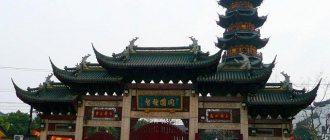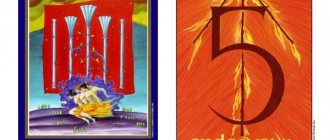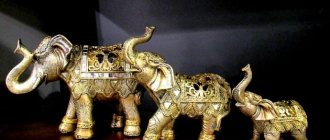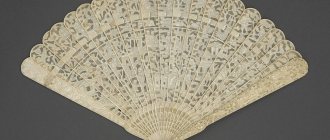dolio.ru » Feng Shui » Chinese pagoda according to Feng Shui - a universal talisman for all ills
The Chinese pagoda is a unique architectural structure, the general features of which are familiar to everyone. Multi-level, pointed roofs located on multiple tiers of a small building can be seen in China, Japan, Thailand, Vietnam, Cambodia and other countries where Buddhism is practiced. In addition, the pagoda is now actively used as a protective Feng Shui talisman, the properties of which we will discuss below.
Pagoda: from history to modern times
For the first time, pagodas began to be built many thousands of years ago and were initially used in China as small extensions to Buddhist monasteries, which were also considered original temples. But religious ceremonies were never held in them and prayers were never read. Most often, various jewelry and sacred relics were simply kept here, such as the remains of Buddha and other similar things. Because of this, it was believed that the pagoda radiates powerful positive energy around itself, which is capable of clearing the surrounding world of negativity and preventing its further spread.
Because of this, over time, pagodas began to appear not only next to monasteries, but also in cities - in the middle of parks, alleys and even streets, because it was believed that in this way they bring harmony to the surrounding space and thereby favorably influence the overall atmosphere in the city. city.
Also, in many Chinese myths, pagodas are depicted as an effective means of rehabilitating evil demons. For this reason, Eastern practitioners consider them an excellent talisman for fighting evil of various origins and types.
Symbolism
Pagodas have a special architecture for a reason. Created in several tiers, it reflects the cyclical repetition of the events of our lives, the movement in a spiral.
It is believed that the number of tiers also hides a certain sacredness. For example, the number “seven” directly indicates the Buddhas of different times who incarnated in the human world.
Others see the pagoda as a symbol of Mount Meru - the Buddhist center of the universe, at the top of which the gods live. Each tier is a certain heaven, which can be achieved by constant growth and upward striving. However, the atypical roof structure has a practical purpose: upturned eaves retain moisture after rain or snow, preventing it from flowing down and gradually destroying the facade.
The imperial pagodas were of particular importance. As usual, they had a majestic, sometimes even sublime appearance. The main attribute is the yellow tiled roof, the color of which represents the strength of the ruler.
Recently, many famous pagodas, especially in tourist areas, have been opened to the public. Although ordinary visitors will hardly be able to see the rituals, ceremonies and interior decoration of the upper floors, here you can feel the spirit of Buddhism and lift the veil of secret mysteries.
Five Elements Pagoda
Another type of talisman we are considering is the pagoda of the five elements. It is completely different from the Chinese pagoda in appearance, because it consists of 5 elements, personifying the five main elements. This is an equilateral cube, a regular sphere, a four-sided pyramid, a small hemisphere and a pointed cone, located one above the other in a cycle of creation. The cube represents the Earth, the sphere – Metal, the pyramid – Water, the cone – Fire.
In order for such a pagoda to “work”, each of the presented sections (most often they are hollow) must be filled with material corresponding to a particular element:
- pour fresh soil into the cube,
- into the sphere - metal filings,
- fill the pyramid with pieces of blue glass,
- hemisphere - wood sawdust
- and finally the cone with finely chopped red paper.
Once all sections are filled, such a pagoda will become a reliable protector of the house from evil, including flying stars.
Architectural delights
Chinese builders erected structures using original technology based on the wooden frame structure “dougong”, translated as “bucket and beam”. Not a single iron nail was used in the construction of such houses. Having arranged the pillars in a certain order and fastened them with crossbars, the Chinese installed a frame, which was subsequently covered with a roof made of heavy tiles. But the most interesting thing: to relieve pressure on the pillars, the Chinese built truncated pyramids from wooden blocks, the wide bases of which rested on the upper ceiling, and the tops on the pillar. As a result, the entire load falls on these blocks, which differed in size and shape and were called “dow” - “bucket”, respectively, “gun” - “beam”.
Thus, the pagoda is an amazing structure in which the walls do not bear any load. They perform the functions of partitions and allow you to install windows and doors in any quantity.
Pagodas with other talismans
Combining a pagoda with a turtle, dragon or tiger is just one way to enhance its energy. Such a talisman will best manifest itself where the animal present in it feels good. For example, a pagoda with a turtle can be placed in the north, where it will contribute to faster career advancement. Whereas it is better to place a pagoda with a tiger in the west, where this striped animal helps to maintain health.
Era styles
Han dynasty
Examples of tower architecture from the Han Dynasty, which predates the influence of Buddhism, and a full-fledged Chinese pagoda can be seen in the four photographs below. Michael Lowe writes that during the Han Dynasty (202 BC - 220 AD), multi-story towers were erected for religious purposes, as astronomical observatories, as watchtowers, or as ornate buildings, which were believed to attract the favor of spirits, deities and immortals.[21]
- Ancient Chinese model of two residential towers made from pottery during the Han Dynasty, 2nd century BC to 2nd century AD
- Side view of a Han pottery model of a tower with a balcony on the middle floor and a gatehouse in the courtyard surrounded by smaller towers; V Dugun
the support brackets are clearly visible.
- Western Han model of a watchtower with human figures on the balconies (including crossbowmen), a gatehouse and a courtyard on the ground floor.
- Among a large selection of architectural models, three Eastern Han Dynasty watchtowers stand at the rear of this display.
Sui and Tang
Pagodas built during the Sui and Tang dynasties generally had a square base, with a few exceptions such as the Daqin Pagoda:
- Four Gate Pagoda, 611 buildings.
- The Daqin Pagoda, built in 640.
- The Little Wild Goose Pagoda, built in 709.
- Baoguang Temple Pagoda, built between 862 and 888.
Kingdom of Dali
- The Three Pagodas, 9th-10th centuries.
Song, Liao, Jin, Yuan
The pagodas of the Five Dynasties, Northern and Southern Song, Liao, Jin and Yuan Dynasties included many new styles with greater emphasis on hexagonal and octagonal pagoda bases:
- The Huqiu Tower, built in 961.
- Longhua Pagoda, built in 977.
- Fogong Temple Pagoda, built in 1056.
- The Liaodi Pagoda, built in 1055
- Pizhi Pagoda, built by 1063.
- Haotian Pagoda, built in 1103.
- Pagoda of Tianning Temple in Beijing, 1120.
- The Chenglin Pagoda, built in 1189.
- Win Pagoda, built in 1270.
- Bailin Temple Pagoda, built by 1330.
- The Songjiang Square Tower, Shanghai, built in 1884.
Ming and Qing
Pagodas in the Ming and Qing dynasties largely inherited the styles of previous eras, although there were some minor variations:
- Zhenjue Temple, built in 1473.
- In the Pagoda of Qishou Temple, built in 1576.
- The Sarira Stupa of Taiyuan Temple, built in 1582
- The Pagoda of Fragrant Hills, built in 1780.
Pagoda pendants
Small keychains with pagodas are excellent talismans for those who want to always have some kind of amulet with them. After all, the pagoda perfectly cleanses any space around it, be it at home or on the street. However, in China there has been a tradition of giving such amulets specifically to students or students. It is generally believed that pagodas are great for studying and are especially useful during exams.
Content
- 1 Etymology
- 2 History 2.1 China
- 5.1 Wood
- 7.1 Han dynasty
Weather care
Finally, I would like to say a few more words about caring for this truly universal talisman. Cleaning a space is an energy-consuming procedure, so in addition to keeping it clean and careful handling, the pagoda requires recharging from time to time. To do this, you need to wipe it more often with water mixed with salt, and also wrap it in a red cloth for a while. And sometimes you need to change its location in the apartment, moving it from one sector to another. This will give her the opportunity to “recharge” in time and restore wasted strength.
Share
Notes
- "The Origin of Pagodas". china.org.cn. September 19, 2002. Retrieved January 23, 2022.
- The Evolution of Indian Stupa Architecture in East Asia
. Eric Stratton. New Delhi, Vedama, 2002, viii, ISBN 81-7936-006-7 - ^ a b c d
Pagoda at
Encyclopedia Britannica - Architecture and construction
. W. T. Comstock. 1896. p. 245. - Steinhardt, 387.
- Chinese Origin of the Term "Pagoda": A Proposed Etymology by Liang Sicheng Authors: David Robbins Tien Publication: Acta Orientalia, Volume 77 (2016), pp. 133–144 David Robbins Tien, Gerald Leonard Cohen Publication: Research and Creative Works of the Faculty of Arts, Languages and Philosophy DownloadTien, D. R., & Cohen, G. L. (2017) https://scholarsmine.mst.edu/artlan_phil_facwork. David Robbins Tien. Comments on etymology. October 2014, T. 44, issue. 1. pp. 2–6.
- Random House Complete Dictionary
, Second Edition. Random House, New York, 1993. - Hobson-Jobson: An English-Indian Dictionary
by Henry Yule and Arthur Coke Burnell, first printed 1896, reprinted by Wordsworth Editions, 1996, p. 291.
Online Dictionary of Etymology
Douglas Harper, s.v.
pagoda
, at https:// www.etymonline.com/ (Accessed April 29, 2016) - World History of Architecture
. Michael V. Fazio, Marian Moffett, Lawrence Woodhouse. Published 2003 by McGraw-Hill Professional. ISBN 0-07-141751-6. - The influence of Buddhism on the material culture of China
. John Kishnik. Published 2003 Princeton University Press. ISBN 0-691-09676-7. - Benn, 62 years old.
- The influence of Buddhism on the material culture of China
By John Kieschnick. Published 2003. Princeton University Press. ISBN 0-691-09676-7. paragraph 83 - The influence of Buddhism on the material culture of China
By John Kieschnick. Published 2003 Princeton University Press ISBN 0-691-09676-7. paragraph 84 - Brook, 7.
- ^ a b
Himes, 30. - The influence of Buddhism on the material culture of China
. John Kishnik. Published 2003. Princeton University Press. ISBN 0-691-09676-7. page 83 - The influence of Buddhism on the material culture of China
. John Kishnik. Published 2003. Princeton University Press. ISBN 0-691-09676-7. page 84 - Terry, T. Philip (1914). Japanese Empire Terry
. Houghton Mifflin. paragraph 257. - Chihara, Daigoro (1996). Hindu-Buddhist architecture in Southeast Asia
. BRILL. paragraph 28. ISBN 90-04-10512-3. - ^ a b
Steinhardt, 383. - Loewe (1968), 133.
- "Indianapolis 500 Traditions :: Indianapolis 500." May 1, 2008 Archived from the original on May 1, 2008.
Recommendations
- Benn, Charles (2002). China's Golden Age: Everyday Life in the Tang Dynasty
. Oxford: Oxford University Press. ISBN 0-19-517665-0. - Brooke, Timothy. (1998). A Confusion of Pleasures: Trade and Culture in Ming China
. Berkeley: University of California Press. ISBN 0-520-22154-0 - Fazio, Michael W., Moffett, Marian and Woodhouse, Lawrence. World History of Architecture
. Published 2003 by McGraw-Hill Professional. ISBN 0-07-141751-6. - Fu, Xinyan. (2002). "Three Kingdoms, Western and Eastern Jin, Northern and Southern Dynasties" in Chinese Architecture
, 61–90. Edited by Nancy S. Steinhardt. New Haven: Yale University Press. ISBN 0-300-09559-7. - Govinda, A.B. Psychocosmic symbolism of a Buddhist stupa
. 1976, Emeryville, California. Dharma Publications. - Hymes, Robert P. (1986). Statesmen and Gentlemen: The Elite of Fu-Chou, Chang-Hsi, in the Northern and Southern Song. Cambridge: Cambridge University Press. ISBN 0-521-30631-0.
- Keshnik, John. The influence of Buddhism on the material culture of China
. Published 2003. Princeton University Press. ISBN 0-691-09676-7. - Lowe, Michael. (1968). Daily life in early imperial China during the Han period 202 BC.
- 220 AD . London: BT Batsford Ltd.; New York: GP Putnam's Sons. - Steinhardt, Nancy Schatzman (1997). Liao Architecture
. Honolulu: University of Hawaii Press.
Where to buy a talisman
You can buy the Pagoda of Five Elements amulet for 2,368 rubles on AliExpress. Shipping from China is free. The talisman is made of copper and painted in five colors. The amulet consists of five elements: Earth, Metal, Water, Wood and Fire. The talisman has Chinese characters on it.
The 5 Elements Pagoda is suitable for students and writers, which you can buy on AliExpress. The price of the amulet is 885.76 rubles. Free delivery. The Wen Chang talisman has nine levels. You can take it with you, as its dimensions are small: 6 x 15 cm, weight - 210 grams.
What shapes do towers come in?
Liang Sicheng is the first Chinese scholar to develop a typology of pagodas. According to this doctrine, there are two types of structures:
- Chinese multi-story buildings, Indian stupas.
There are seven types of pagodas depending on their shape:
- tower,
- pavilion,
- multi-eaves,
- mortar,
- diamond throne,
- Buddhist Canon,
- sculpture
Not only the designs, but also the number of tiers can be different. More often they built towers of twelve and nine tiers. The number of levels does not affect the strength of the talisman.
Safety technology
One nuance of using the “Pagoda” talisman must be taken into account: by absorbing energy, it can weaken the power of the one who receives it from the sector where it hangs.
This happens if the Pagoda is in the sector for a long time. In this case, it loses its positive properties.
For example, when the Pagoda is placed in the room of a sick person, it “absorbs” the negative energy of the disease, but after healing the pagoda must be allowed to rest (you can wrap it in red cloth), otherwise the talisman will provoke illness.
Famous towers
Nepal is considered the birthplace of the pagoda, from where it spread throughout the world.
There are pagodas in the following countries:
Tiger Hill
In China, one of the favorite places for tourists is the 10th-century leaning pagoda, which is located at the foot of the mountain. “Tiger Hill” is a complex of parks with pagodas. There is a bamboo grove, a tea plantation, buildings, and pavilions. Everything is surrounded by greenery, birds sing and cicadas chirp.
According to legend, a ruler is buried here, and his grave is guarded by a tiger, which is why the hill has this name. The park with plants, water, houses and an ancient tower resembles a fairy tale.
Pagoda Hangzhou
The octagonal Lei Feng Tower is located in Hangzhou in China. The structure was built in 975 AD. e. In 1924 the tower collapsed due to vandalism. Bricks that were considered magical were stolen. In 2002, the ancient building was reconstructed.
There is an ancient Chinese parable called “The Monk and the Snake.” According to legend, a young man fell in love with a snake, which turned into a woman. They decided to separate them. The snake woman was buried and a tower was placed on top so that she could not get out.
Single column tower in Hanoi
The building was built in 1049 and resembles a lotus flower. The architectural structure was erected according to the description of the dream of Emperor Ly Thai Tong. He built the tower in gratitude for his newborn son. The emperor had a dream where Avalokiteshvara was holding out a baby.
Lee Thai Tong got married and had a son. The tower was erected on one pillar in the middle of a lotus pond - this is how the emperor saw it in a dream.











